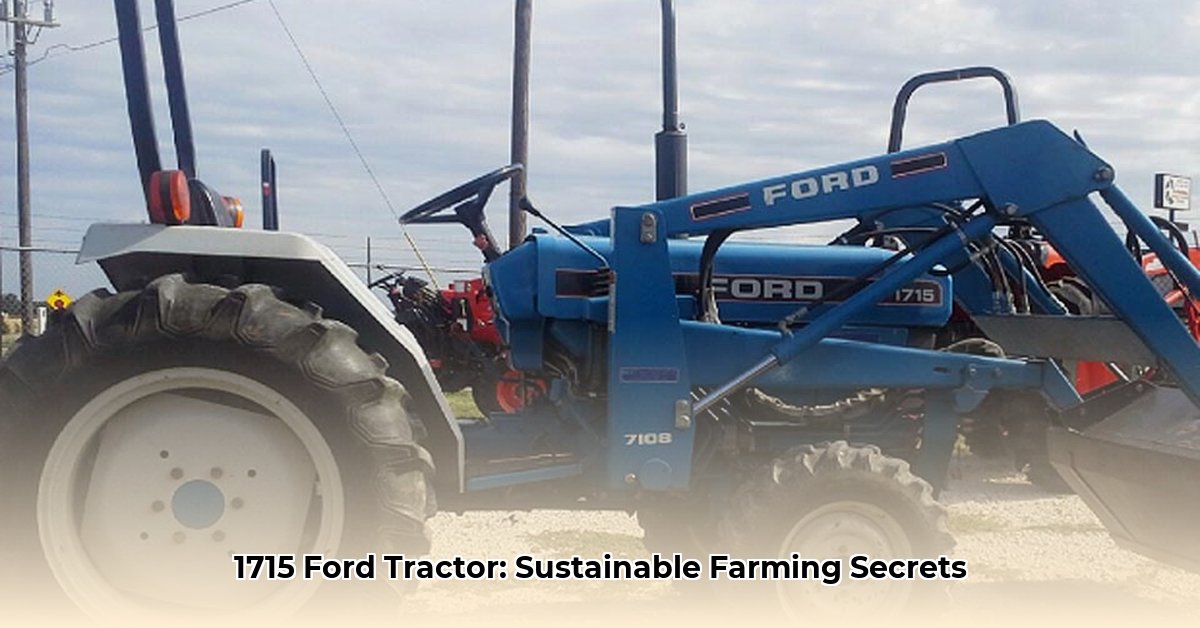
The Ford 1715: A trusty workhorse from the 1990s, quietly making a comeback in the world of sustainable farming. This compact tractor, produced between 1992 and 1997, offers a compelling blend of fuel efficiency, manageable size, and durable construction, making it an attractive option for smaller farms and environmentally conscious farmers. But how well does it perform? This guide delves into the 1715's specifications, explores its role in sustainable agriculture, and provides actionable steps for keeping this vintage machine running smoothly. For even more detailed specs, check out this helpful resource: Ford 1715 Specs.
1715 Ford Tractor Specifications: A Detailed Look
Understanding the Ford 1715's capabilities begins with its specifications. While precise details can vary based on the year of manufacture and specific configuration, here's a general overview:
| Specification | Details | Notes |
|---|---|---|
| Engine | Shibaura-built diesel | Specific model varies; consult your owner's manual. |
| Horsepower | Approximately 15-20 HP (horsepower) | Actual horsepower can fluctuate slightly. |
| Transmission | Manual (typically) | Specific gear ratios vary; consult your owner's manual. |
| Weight | Approximately 2,000-2,500 lbs (pounds) | Weight varies depending on added equipment. |
| Dimensions | Variable (length, width, height) | Dimensions significantly depend on configuration and implements attached. |
| PTO (Power Take-Off) | Variable (horsepower and RPM) | PTO horsepower and RPM are detailed in the owner's manual. |
| Hydraulic System | Variable (capacity and type) | Specifics detailed in your owner's manual. |
Remember: Always consult your owner's manual for precise specifications relevant to your specific 1715 model. This is crucial for maintenance, repairs, and ensuring safe operation.
The Ford 1715 and Sustainable Agriculture: A Perfect Match?
The 1715's resurgence in popularity isn't accidental. Its characteristics align surprisingly well with the goals of sustainable agriculture. But is it the right choice for every sustainable farm? Let's examine both sides.
Advantages in Sustainable Farming:
- Reduced Soil Compaction: The smaller size and weight minimize soil disturbance, preserving soil structure and promoting healthier root systems. Isn't healthy soil the foundation of successful, sustainable farming?
- Fuel Efficiency: The Shibaura diesel engine is known for its relatively low fuel consumption compared to larger tractors, resulting in both cost savings and a smaller environmental footprint. How much can you save on fuel costs annually?
- Maneuverability: Its compact dimensions make it adept at navigating confined spaces, ideal for smaller farms or specialized tasks requiring precision.
- Versatility: While not inherently so, the 1715's ability to accommodate various implements expands its usefulness across diverse agricultural operations.
Challenges in Sustainable Farming:
- Parts Availability: Sourcing replacement parts for older machinery can be difficult and time-consuming. Finding original parts might be costly; aftermarket parts could compromise quality.
- Maintenance Expertise: Repairing and maintaining a vintage tractor often requires specialized knowledge and skills. Finding qualified mechanics familiar with this model might prove challenging.
- Repair Costs: Due to its age, the 1715 might require more frequent and potentially costly repairs than newer models. Planning for unexpected expenses is crucial.
Maintaining Your 1715: A Practical Guide to Longevity
Keeping your Ford 1715 in top condition requires a proactive approach. Here's a framework for success:
- Develop a Local Mechanic Network: Build relationships with local mechanics experienced with older tractors. Personal connections are often invaluable.
- Embrace Online Communities: Join online forums and groups dedicated to Ford tractors. This access to collective knowledge and shared experiences is a huge benefit.
- Prioritize Preventative Maintenance: Regular inspections, fluid checks (engine oil, transmission fluid, coolant), and filter replacements (air, fuel, hydraulic) are essential. Addressing small concerns before they escalate saves you time and money in the long run. How much preventative maintenance saves you annually?
- Creative Parts Sourcing: Explore online marketplaces, salvage yards, and tractor part specialists when facing part shortages.
- Consider Biodiesel: Investigate the viability of using biodiesel as an alternative fuel. This transition must be carefully researched to ensure compatibility with the engine and avoid potential damage.
The Future of Sustainable Farming: Your Role
The Ford 1715's continued relevance in sustainable agriculture isn't solely about the tractor itself; it's about resourcefulness, community support, and commitment to environmentally conscious farming practices. Whether you are a farmer, a parts supplier, a researcher, or simply passionate about sustainable agriculture, you have a valuable role to play. Share your expertise and contribute to the ongoing conversation about innovative and sustainable farming.
Key Takeaways
- The Ford 1715 offers a compelling blend of size, fuel efficiency, and durability, aligning well with sustainable agriculture goals.
- Maintaining a vintage tractor requires a proactive approach that emphasizes preventative maintenance and resourceful parts sourcing.
- Effective community engagement and knowledge sharing are crucial for the continued success of utilizing vintage tractors in sustainable farming.